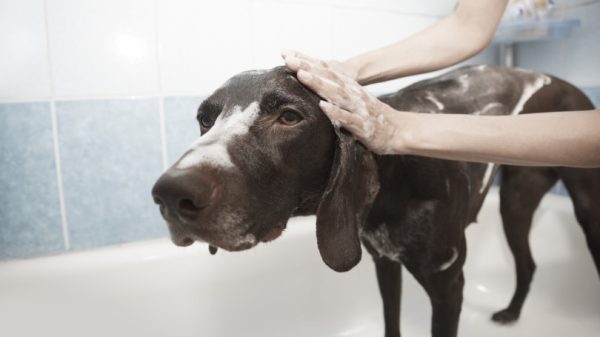In this article
Schools are not typically places that you think about when you think of dogs. Most people went to school without the presence of any animals at all. Recently, more schools have opted to employ the use of trained therapy dogs to help their students. Schools are using new data to tap into the benefits of therapy dogs. Here’s everything you need to know about therapy dogs, including the benefits, how they are used, the drawbacks, and some frequently asked questions.

How Do Therapy Dogs in Schools Work?
Emotional support or therapy dogs are brought into a school with the approval of the school administration. The school will determine whether a therapy dog would be beneficial, and then they reach out to a local group to organize the visit. The therapy dog is then brought into school with its trained handlers.
Some therapy dogs spend time in the hallways greeting students between classes, and other therapy dogs will spend time in individual classrooms. Therapy dogs are always under the supervision of the handlers and with the school’s approval.
Sometimes, the kids will be allowed to interact with the dog by touching them and petting them, and in other cases, the dogs are there just to provide emotional support from afar. The dogs are typically scheduled to appear for a day or two here and there but are not permanent features of the school (that would be more like a class pet than a therapy dog).


The 4 Reasons for Therapy Dogs in Schools
1. Stress Relief
One of the biggest benefits shown with therapy dogs is stress relief. Dogs trained for stress relief can be brought in before or during stressful situations. Stressful situations can include exams or whenever a school is undergoing a large change. Therapy dogs can be brought in at the start of a new school year to help kids feel more at ease about starting a whole new semester. Stress relief benefits have also been shown to affect college students, sometimes more so than younger students.
2. Security
Therapy dogs do not carry out security work like police dogs, but they can make schools feel safer and more secure. There are situations where children do not want to go to school for fear of bullying, because of social pressures, anxiety, or after a scary event. Bringing a therapy dog in can entice students to return to school and can make the hallways feel safer and friendlier than they did before.
3. Emotional Support
Emotional support therapy dogs are general therapy dogs that can help students regulate their emotions. Emotional support dogs can play a number of roles, including grief counseling or stress relief. But they can also be brought in as a treat to help kids feel more upbeat rather than solely being used in conjunction with stress or pain. Emotional support dogs are the most general and most versatile of the different types of therapy dogs as they can be used in a number of different roles.
4. Grief Counseling
Therapy dogs have been shown to be excellent during periods of grief in schools. Therapy dogs have been making the news more and more when they appear in schools after a traumatic event. Therapy dogs have been used in the wake of school shootings and in situations in which a student died suddenly due to an accident (such as a car wreck). These dogs have been shown to help children process grief and feel more comfortable around their peers after a traumatic event.


Where Are Therapy Dogs Used in Schools?
Therapy dogs can be used in all school environments. Therapy dogs have appeared in elementary schools, middle schools, high schools, and universities. Any school environment that approves the use of a therapy dog can reap the benefits. Therapy dogs have been used in both public schools and private schools. In early years settings, such as preschool, there are more factors to consider before allowing a therapy dog onto the premises. Small children have less awareness about how to treat an unfamiliar dog than older students. The dangers are, therefore, higher for the smallest children compared to older children. However, small children can benefit immensely from interacting with dogs, and some early years settings do welcome a therapy dog for this reason.
Advantages of Therapy Dogs in Schools
There are a number of noted benefits of therapy dogs in schools. Therapy dogs can make kids feel happy. Therapy dogs can break up the monotony of the day, which can help improve focus for the rest of the day. Therapy dogs have been shown to help reduce stress and help children process grief. The presence of a therapy dog during stressful times or after an emotional event can provide benefits to the entire student body. For example, if a child is unwilling to go to school because of a test or because of a traumatic event, a therapy dog can entice children to return and help smooth their fears and anxiety about the school environment at the time.
- Stress relief
- Brings joy
- Emotional regulation
- Makes school feel safe and welcoming
Disadvantages of Therapy Dogs in Schools
The disadvantages of bringing therapy dogs into a school include the fact that they are seen as a distraction. It is hard to learn and pay attention when there is an adorable dog in the room. Some people are also concerned with the fact that some kids are allergic to dogs. Some kids are also scared of dogs after having bad experiences with them in the past. Detractors say that therapy dogs do not benefit all kids equally, and therapy dogs can even be a detriment to some students, which is unfair. A therapy dog that makes a kid feel scared, allergic, or out of place can actually cause the opposite of the intended effect by making their day worse, not better.
- Distracting
- Can cause allergies
- Can scare kids
- Can isolate kids from the main group

Frequently Asked Questions (FAQ)

Is It Fair to the Dogs?
Given the significant number of variables in a school setting, it is not always a suitable environment for dogs. It largely depends on the level of care associated with the dogs and the school administration. Most therapy dogs in schools will have a trained handler who takes the dog home after their school visit, so this designated carer should be with the dog at all times. However, schools are noisy and often unpredictable places with new people, loud sounds and crowds of kids all the time. This is likely to be a fairly stressful environment, even for the calmest of dogs. For these reasons, many pet advocates have spoken out against therapy dogs in schools.
Which Breeds Make the Best Therapy Dogs?
According to US Service Dogs, the three breeds that make the best therapy dogs are Labrador Retrievers, Golden Retrievers, and Poodles. Therapy dogs are chosen primarily for their temperament and trainability. In each of these cases, these breeds possess amiable temperaments and are easily trainable. Other popular therapy dog breeds include Border Collies, Yorkshire Terriers, and Pugs. Size is also a factor when determining a good therapy dog. Sometimes, people like large dogs that they can pet and hug, and other times, small dogs that shed very little are ideal for school environments.
Do Schools Have to Tell Parents Before Bringing a Dog Around?
There are no official guidelines that govern all public schools regarding therapy dog usage. In most situations, the school will alert parents to the potential presence of a therapy dog on campus. This is because of potential allergies, fears, and dangers that can arise with a therapy dog. It is good practice for a school to alert parents before a therapy dog is brought in, but there is nothing that says that such a warning is necessary.
Are Therapy Dogs Effective on College Campuses?
Previously, it was believed that therapy dogs only had tangible benefits in primary education settings. People believed that younger children received more benefits from therapy dogs than university students. However, new data now suggests that therapy dogs are also effective on college campuses in addition to elementary schools. University students receive large benefits in stress relief from the presence of therapy dogs, which can help students feel less overwhelmed by the college experience.
Are Therapy Dogs Becoming More Common?
Yes. The use of therapy dogs is becoming more common in schools. As the benefits become more understood and as dogs become a more accepted part of general society, they have been used more in educational settings. Therapy dogs have also become more common on college campuses in the run up to exams or stressful situations like career day. Therapy dogs in schools today are much more common than they were even a decade ago, and that trend looks set to continue into the future.
Can Kids Bring Their Own Therapy Dogs to School?
In rare cases, children may be able to bring their own therapy dog to school if the dog has been medically prescribed for the child’s overall wellbeing. Any therapy dog brought to school by a child would have to have an official prescription from a medical provider, and the dog would have to be approved by the school. This is very rare and does not happen often, but it is not impossible. There are thousands of schools and millions of students in the country, and it is not impossible for some of them to have permission to attend school with their own therapy dogs. But you cannot send an unofficial emotional support animal to school with a child.

Conclusion
Therapy dogs have been proven to be effective in emotional support and stress relief in schools. Thanks to that new data, more and more schools are choosing to use therapy dogs with their students. Therapy dogs are becoming more common, and they are often deployed after traumatic situations to help schools feel safe and welcoming while also helping students process complex emotions that they might not be ready to tackle. It is good to brush up on the basics of therapy dogs in schools because it is likely that your child will come across a school therapy dog at some point during their school years.
Featured Image Credit: gpointstudio, Shutterstock


















